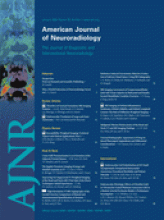Abstract
BACKGROUND AND PURPOSE: For CT scan planning, scan projection radiographs (SPR) are used. Tube tension and current for head SPR can be reduced to a minimum because of the small head diameter and because only high-contrast structures need to be visualized for planning. The goal of this study was to investigate SPR of the head in respect to effective doses, the influence of dose-reduction measures, and comparison with conventional x-ray.
MATERIALS AND METHODS: Entrance doses for default and minimal settings were measured on a LightSpeed Ultra CT scanner and on conventional x-ray equipment. Effective doses for different scanning fields of the head were calculated for an adult, a 10-year-old child, and a neonate by using the commercially available software PCXMC.
RESULTS: Depending on projection and technique, SPR effective doses for adults were 1.9–27.7 μSv; for the 10-year-old child, 2.1–31.1 μSv; and for the neonate, 5.2–97.2 μSv. Doses with the tube under the table were 1.3–3.4 times lower. Doses for conventional radiography were higher than SPR doses for adults and partially lower for children.
CONCLUSIONS: Depending on the scanning technique, effective doses for head SPR can differ up to 17-fold. The dose is significantly reduced by lowering tube voltage and current, by positioning the tube under the table, and by keeping the thyroid out of the scan or by protecting it with a lead collar. Compared with the conventional x-ray technique, SPR doses tend to be lower due to x-ray beam characteristics.
- Copyright © American Society of Neuroradiology












